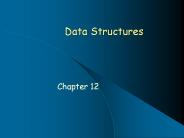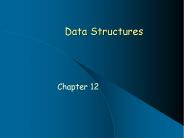Linkedlist PowerPoint PPT Presentations
All Time
Recommended
LinkedList in Java Vishnu Kotrajaras, Ph.D. ...
| PowerPoint PPT presentation | free to download
Jones, William. HashMap. Table consisting of two columns. Column 1 ... Jones, ... Jones, William. 256-41-0920. Madden, Matt. Keys. Values. sorted ...
| PowerPoint PPT presentation | free to view
Linked lists allow for random insertion and deletion ... Stop for a Pause. For the few of you that all that made sense to, go ahead and use it. ...
| PowerPoint PPT presentation | free to view
first. 18. Ruli Manurung (Fasilkom UI) IKI10100I: Data Structures & Algorithms. Week 6 ... contains no data, but serves to ensure that first 'real' node in ...
| PowerPoint PPT presentation | free to view
??????????????????????????????????????????. ????????????????? ... Public E set(int index, E element) ???????????????? index ??????????????????????????????????? ...
| PowerPoint PPT presentation | free to view
To let ListIterator access the private member head, we make ListIterator ... An iterator is a construct ... multimap _ Hash table, supports numerous values ...
| PowerPoint PPT presentation | free to download
if traversal has reached the end of the list or // the list is empty, just return ... if prevPtr == rear, we are inserting into empty list ...
| PowerPoint PPT presentation | free to view
Data Structures Chapter 12 Chapter Contents Chapter Objectives 12.1 Introductory Example: Counting Internet Addresses 12.2 The ArrayList and LinkedList Classes 12.3 ...
| PowerPoint PPT presentation | free to download
Show how to build collection classes. Study the stack and queue structures ... Uses the LinkedList constructor to build an empty list. head size tail. 0 ...
| PowerPoint PPT presentation | free to download
... for last node a separate dummy node class / object CS314 Linked Lists * A Linked List Implementation public class LinkedList
| PowerPoint PPT presentation | free to download
LinkedList with two elements. The significance of the header entry ... One line is designated the current line. Each editing command begins with ...
| PowerPoint PPT presentation | free to view
reverse. put. add. lookup. BinaryTree. HeapArray. LinkedList. TreeMap. HashSet. AVTree. methods checked for all inputs up to given size ...
| PowerPoint PPT presentation | free to view
Collections represent data items that should be naturally grouped ... A telephone directory (a collection of name to phone number mappings) LinkedList & ArrayList ...
| PowerPoint PPT presentation | free to view
Java's Iterator Interfaces. Chapter 8. 2. Chapter Contents. The Interface Iterator ... Java Class Library: ArrayList and LinkedList Revisited ...
| PowerPoint PPT presentation | free to view
Show the traversal of the Linked List during insertion ... Field1. UML Diagrams-Design of S/W. JApplet. LinkedList. init() disablebuttons() menuAction(String) ...
| PowerPoint PPT presentation | free to view
... 'elegant', it is really no improvement over the singly and doubly ... LinkedList only stores 'Objects' of type E. Winter 2006. CISC121 - Prof. McLeod. 31 ...
| PowerPoint PPT presentation | free to download
Use a pointer and new to create the array ... Implementing Collections through a Data Structure. class Catalog. private: LinkedList booklist; ...
| PowerPoint PPT presentation | free to download
In the previous example, descendants of LinkedList do not share friendship priviledges in Link. ... new operators by 'overloading' symbols that are not already ...
| PowerPoint PPT presentation | free to view
LinkedList methods:append (cont.) Create a new Node containing the element to be appended ... get, append, remove, and add all require linear time on average. ...
| PowerPoint PPT presentation | free to download
Java's Iterator Interfaces. Chapter 8. 2. Chapter Contents. The Interface Iterator ... import java.util. ... Java Class Library: ArrayList and LinkedList Revisited ...
| PowerPoint PPT presentation | free to view
Example: add in ArrayList BankAccount has type variable E replaced with BankAccount: ... Can add a String into a LinkedList intended to hold bank accounts ...
| PowerPoint PPT presentation | free to view
A blockchain is a singly LinkedList of block, with each block containing a number of transactions. It provides a decentralised, immutable data store that can be used across a network of users, create assets and act as a shared black book that records all transactions. Each transaction can be easily queried, affording greater transparency and trust to all parties involved.
| PowerPoint PPT presentation | free to download
... motes. Each mote sents its packets to this module which forwards it to those motes that ... The connectionManager.java manages the linkedlist of mote IDs. ...
| PowerPoint PPT presentation | free to view
... letters, and its arguments are enclosed in parentheses: toString(), Math.abs(n) ... both ArrayList (fast random access) and LinkedList (fast insertions and ...
| PowerPoint PPT presentation | free to download
return node containing element being deleted to the heap. deleting first node is a special case ... LinkedList class uses the heap. heap space is allocated node ...
| PowerPoint PPT presentation | free to view
Star Trek 3,50. Terminator VII 6,00. Lion King 3,00. Overall price 12,50 // overall price ... private List Rental rents = new LinkedList Rental ...
| PowerPoint PPT presentation | free to view
void addFirst(Object ob) Add all the element from the Collection col at the position pos. ... (Collection col) Return true if the list contains the Object ob. ...
| PowerPoint PPT presentation | free to view
Title: PowerPoint Presentation Last modified by: davise Created Date: 1/1/1601 12:00:00 AM Document presentation format: On-screen Show Other titles
| PowerPoint PPT presentation | free to download
Chapter 7 Linked Lists
| PowerPoint PPT presentation | free to download
An Introduction to Data Structures Advanced Programming ICOM 4015 Lecture 17 Reading: Java Concepts Chapter 20
| PowerPoint PPT presentation | free to download
Title: CS 195 Course Outline & Introduction to Java Author: nwang Last modified by: nwang Created Date: 5/5/2000 9:02:18 PM Document presentation format
| PowerPoint PPT presentation | free to view
The most important thing for good preparation is the appropriate and suitable choice of study material. Our experts have done an endeavor to help IT candidates providing a fully valid and authentic study guide.
| PowerPoint PPT presentation | free to download
Dynamic memory allocation Recall memory space for method variables parameters and local variables is allocated when the method is invoked, ...
| PowerPoint PPT presentation | free to view
Title: 1 Author: lik2 Last modified by: Ki-Joune Li Created Date: 1/12/2004 8:00:17 AM Document presentation format: (4:3)
| PowerPoint PPT presentation | free to view
The stack abstract data type is essentially a list using the LIFO ... parenthesis ... expression, until a left parenthesis is popped (but not output) A left parenthesis ...
| PowerPoint PPT presentation | free to download
public int mAge; public override bool Equals(object aObject) ... st1.mAge = 68; Console.WriteLine(st1); // ??????? ?? st1.ToString() Student st2 = new Student ...
| PowerPoint PPT presentation | free to download
Making the future safe for the past : (time paradox) ... JSR-000014 Adding Generics to the JavaTM Programming Language. http://jcp.org/jsr/detail/14.jsp ...
| PowerPoint PPT presentation | free to view
For more course tutorials visit www.tutorialrank.com General Instructions Exercises 1, 2, 4, and 5 use the programs in DocSharinglabeled “User-defined classes." Exercises 7 and 8 use the programs in DocSharinglabeled “Using interfaces." Exercise 1: Review of classes Create a project using the classes in the DocSharing area labeled “User-defined classes." Compile it, run it, and review the code that is given carefully. Exercise 2: User-defined methods
| PowerPoint PPT presentation | free to download
Then we'll write the add, traverse, find and delete methods (plus helpers if necessary) ... then traverse list (useful for // debugging) // Postcon: No change to list ...
| PowerPoint PPT presentation | free to download
Das Collection-Framework von JAVA ...
| PowerPoint PPT presentation | free to view
Title: PowerPoint Author: 1 Last modified by: mdf Created Date: 8/26/2002 10:37:45 AM Document presentation format: Company
| PowerPoint PPT presentation | free to view
FOR MORE CLASSES VISIT www.ecet370assist.com ECET 370 Week 1 Lab 1 ECET 370 Week 2 Lab 2 ECET 370 Week 3 Lab 3 Linked Lists ECET 370 Week 4 Lab 4 Complexity of Computational Problems ECET 370 Week 5 Lab 5 Search Algorithms and Techniques
| PowerPoint PPT presentation | free to download
For more course tutorials visit www.tutorialrank.com General Instructions Exercises 1, 2, 4, and 5 use the programs in DocSharinglabeled “User-defined classes." Exercises 7 and 8 use the programs in DocSharinglabeled “Using interfaces." Exercise 1: Review of classes Create a project using the classes in the DocSharing area labeled “User-defined classes." Compile it, run it, and review the code that is given carefully. Exercise 2: User-defined methods The function area of the Triangle class is the
| PowerPoint PPT presentation | free to download
FOR MORE CLASSES VISIT www.ecet370assist.com ECET 370 Week 1 Lab 1 ECET 370 Week 2 Lab 2 ECET 370 Week 3 Lab 3 Linked Lists ECET 370 Week 4 Lab 4 Complexity of Computational Problems ECET 370 Week 5 Lab 5 Search Algorithms and Techniques
| PowerPoint PPT presentation | free to download
FOR MORE CLASSES VISIT www.ecet370helps.com ECET 370 Week 1 Lab 1 ECET 370 Week 2 Lab 2 ECET 370 Week 3 Lab 3 Linked Lists ECET 370 Week 4 Lab 4 Complexity of Computational Problems ECET 370 Week 5 Lab 5 Search Algorithms and Techniques ECET 370 Week 7 Lab 7 Binary Trees
| PowerPoint PPT presentation | free to download
For more classes visit www.snaptutorial.com ECET 370 Week 1 Lab 1 ECET 370 Week 2 Lab 2 ECET 370 Week 3 Lab 3 Linked Lists ECET 370 Week 4 Lab 4 Complexity of Computational Problems ECET 370 Week 5 Lab 5 Search Algorithms and Techniques ECET 370 Week 7 Lab 7 Binary Trees
| PowerPoint PPT presentation | free to download
FOR MORE CLASSES VISIT www.ecet370assist.com ECET 370 Week 1 Lab 1 ECET 370 Week 2 Lab 2 ECET 370 Week 3 Lab 3 Linked Lists ECET 370 Week 4 Lab 4 Complexity of Computational Problems ECET 370 Week 5 Lab 5 Search Algorithms and Techniques
| PowerPoint PPT presentation | free to download
General Instructions Exercises 1, 2, 4, and 5 use the programs in DocSharinglabeled “User-defined classes." Exercises 7 and 8 use the programs in DocSharinglabeled “Using interfaces."
| PowerPoint PPT presentation | free to download
FOR MORE CLASSES VISIT www.ecet370assist.com ECET 370 Week 1 Lab 1 ECET 370 Week 2 Lab 2 ECET 370 Week 3 Lab 3 Linked Lists ECET 370 Week 4 Lab 4 Complexity of Computational Problems ECET 370 Week 5 Lab 5 Search Algorithms and Techniques ECET 370 Week 7 Lab 7 Binary Trees
| PowerPoint PPT presentation | free to download
FOR MORE CLASSES VISIT www.ecet370assist.com ECET 370 Week 1 Lab 1 ECET 370 Week 2 Lab 2 ECET 370 Week 3 Lab 3 Linked Lists ECET 370 Week 4 Lab 4 Complexity of Computational Problems ECET 370 Week 5 Lab 5 Search Algorithms and Techniques ECET 370 Week 7 Lab 7 Binary Trees
| PowerPoint PPT presentation | free to download
For more course tutorials visit www.ecet370.com ECET 370 Week 1 Lab 1 ECET 370 Week 2 Lab 2 ECET 370 Week 3 Lab 3 Linked Lists ECET 370 Week 4 Lab 4 Complexity of Computational Problems ECET 370 Week 5 Lab 5 Search Algorithms and Techniques ECET 370 Week 7 Lab 7 Binary Trees
| PowerPoint PPT presentation | free to download
FOR MORE CLASSES VISIT www.ecet370helps.com ECET 370 Week 1 Lab 1 ECET 370 Week 2 Lab 2 ECET 370 Week 3 Lab 3 Linked Lists ECET 370 Week 4 Lab 4 Complexity of Computational Problems ECET 370 Week 5 Lab 5 Search Algorithms and Techniques ECET 370 Week 7 Lab 7 Binary Trees
| PowerPoint PPT presentation | free to download
ECET 370 Week 1 Lab 1 ECET 370 Week 2 Lab 2 ECET 370 Week 3 Lab 3 Linked Lists ECET 370 Week 4 Lab 4 Complexity of Computational Problems ECET 370 Week 5 Lab 5 Search Algorithms and Techniques ECET 370 Week 7 Lab 7 Binary Trees .
| PowerPoint PPT presentation | free to download
For more classes visit www.snaptutorial.com General Instructions Exercises 1, 2, 4, and 5 use the programs in DocSharinglabeled “User-defined classes." Exercises 7 and 8 use the programs in DocSharinglabeled “Using interfaces." Exercise 1: Review of classes Create a project using the classes in the DocSharing area labeled “User-defined classes." Compile it, run it, and review the code that is given carefully
| PowerPoint PPT presentation | free to download
FOR MORE CLASSES VISIT www.ecet370assist.com ECET 370 Week 1 Lab 1 ECET 370 Week 2 Lab 2 ECET 370 Week 3 Lab 3 Linked Lists ECET 370 Week 4 Lab 4 Complexity of Computational Problems ECET 370 Week 5 Lab 5 Search Algorithms and Techniques ECET 370 Week 7 Lab 7 Binary Trees
| PowerPoint PPT presentation | free to download
FOR MORE CLASSES VISIT www.ecet370assist.com ECET 370 Week 1 Lab 1 ECET 370 Week 2 Lab 2 ECET 370 Week 3 Lab 3 Linked Lists ECET 370 Week 4 Lab 4 Complexity of Computational Problems ECET 370 Week 5 Lab 5 Search Algorithms and Techniques
| PowerPoint PPT presentation | free to download
























































